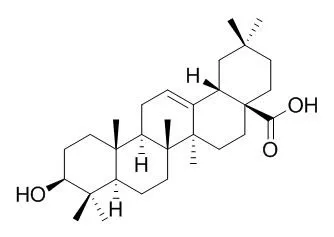| Bioorg Med Chem Lett. 2014 Sep 1;24(17):4114-9. |
| Oleanolic acid analogs as NO, TNF-α and IL-1β inhibitors: synthesis, biological evaluation and docking studies.[Pubmed: 25113933] |
A series of Oleanolic acid analogs, characterized by structural modifications at position C-3 and C-28 of oleanane skeleton were synthesized and assessed for antiinflammatory potential towards lipopolysaccharide (LPS) induced nitric oxide (NO) production in macrophages.
METHODS AND RESULTS:
Results revealed that all the synthesized analogs of Oleanolic acid inhibit NO production with an IC50 of 2.66-41.7 μM as compared to the specific nitric oxide synthase (NOS) inhibitor, L-NAME (IC50=69.21 and 73.18 μM on RAW 264.7 and J774A.1 cells, respectively) without affecting the cell viability when tested at their half maximal concentration. The most potent NO inhibitors (2, 8, 9 and 10) at a concentration of 20 μg/mL also demonstrated mild inhibition (27.9-51.9%) of LPS-induced tumor necrosis factor alpha (TNF-α) and weak inhibition (11.1-37.5%) towards interleukin 1-beta (IL-1β) production in both the cells.
CONCLUSIONS:
The present study paves a direction that analogs of Oleanolic acid can be employed as a lead in the development of potent NO inhibitors. Molecular docking studies also showed that 10 (with top Goldscore docking pose 19.05) showed similar interaction as that of co-crystallized inhibitor and, thereby, helps to design the potent inhibitors of TNF-α. |
| Antiviral Res. 2013 Apr;98(1):44-53. |
| Oleanolic acid and ursolic acid: novel hepatitis C virus antivirals that inhibit NS5B activity.[Pubmed: 23422646 ] |
Hepatitis C virus (HCV) infects up to 170 million people worldwide and causes significant morbidity and mortality. Unfortunately, current therapy is only curative in approximately 50% of HCV patients and has adverse side effects, which warrants the need to develop novel and effective antivirals against HCV. We have previously reported that the Chinese herb Fructus Ligustri Lucidi (FLL) directly inhibited HCV NS5B RNA-dependent RNA polymerase (RdRp) activity (Kong et al., 2007).
METHODS AND RESULTS:
In this study, we found that the FLL aqueous extract strongly suppressed HCV replication. Further high-performance liquid chromatography (HPLC) analysis combined with inhibitory assays indicates that Oleanolic acid and ursolic acid are two antiviral components within FLL aqueous extract that significantly suppressed the replication of HCV genotype 1b replicon and HCV genotype 2a JFH1 virus. Moreover, Oleanolic acid and ursolic acid exhibited anti-HCV activity at least partly through suppressing HCV NS5B RdRp activity as noncompetitive inhibitors.
CONCLUSIONS:
Therefore, our results for the first time demonstrated that natural products Oleanolic acid and ursolic acid could be used as potential HCV antivirals that can be applied to clinic trials either as monotherapy or in combination with other HCV antivirals. |
| Mol Cell Biochem . 2015 Feb;400(1-2):1-7. |
| Oleanolic acid suppresses the proliferation of lung carcinoma cells by miR-122/Cyclin G1/MEF2D axis[Pubmed: 25472877] |
| Oleanolic acid (OA) is a natural compound from plants with anti-tumor activities. However, the mechanism of the inhibitory effect of OA on cell cycle progression has not been completely explored. We employed several lung carcinoma cell lines to investigate the cell cycle-related molecular pathway affected by OA. The data revealed that OA suppressed the proliferation of lung cancer cells in both dose- and time-dependent manners, along with an increase in miR-122 abundance. The suppression of miR-122 abolished the effect of OA on lung cancer cells. CCNG1 and MEF2D, two putative miR-122 targets, were found to be downregulated by OA treatment. Restoring their expression counteracted the effect of OA on lung carcinoma cells. OA was further shown to induce the expression of miR-122-regulating transcriptional factors in lung cancer cells. Collectively, OA induced cell cycle arrest in lung cancer cells through miR-122/Cyclin G1/MEF2D pathway. This finding may contribute to the understanding of the molecular mechanism of OA's anti-tumor activity. |
| J Nutr Biochem . 2014 Nov;25(11):1154-1160. |
| Oleanolic acid inhibits proliferation and invasiveness of Kras-transformed cells via autophagy[Pubmed: 25172632] |
| Oleanolic acid (OA) has been widely studied because of its pleiotropic therapeutic and preventive effect on various diseases. However, the mechanisms of OA's action are still not clear yet, especially its suppressing effect on transformed cells. In this work, we found that OA induced autophagy in normal tissue-derived cells without cytotoxicity. OA-induced autophagy was shown to decrease the proliferation of KRAS-transformed normal cells and to impair their invasion and anchorage-independent growth. Interrupting autophagy rescued OA's effect on the transformed cells. Mouse model experiments also demonstrated that OA suppressed the growth of KRAS-transformed breast epithelial cell MCF10A-derived tumor xenograft by inducing autophagy. Finally, we identified that OA induced autophagy in normal cells by inhibiting the activation of Akt/mTOR/S6K signaling. In conclusions, we found that OA treatment permitted normal cells to undergo autophagy. The induced autophagy was required for OA to prevent or delay the growth of transformed normal cells. |






 Cell. 2018 Jan 11;172(1-2):249-261.e12. doi: 10.1016/j.cell.2017.12.019.IF=36.216(2019)
Cell. 2018 Jan 11;172(1-2):249-261.e12. doi: 10.1016/j.cell.2017.12.019.IF=36.216(2019) Cell Metab. 2020 Mar 3;31(3):534-548.e5. doi: 10.1016/j.cmet.2020.01.002.IF=22.415(2019)
Cell Metab. 2020 Mar 3;31(3):534-548.e5. doi: 10.1016/j.cmet.2020.01.002.IF=22.415(2019) Mol Cell. 2017 Nov 16;68(4):673-685.e6. doi: 10.1016/j.molcel.2017.10.022.IF=14.548(2019)
Mol Cell. 2017 Nov 16;68(4):673-685.e6. doi: 10.1016/j.molcel.2017.10.022.IF=14.548(2019)